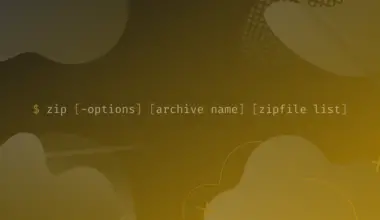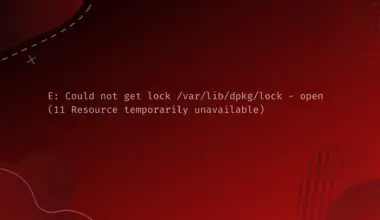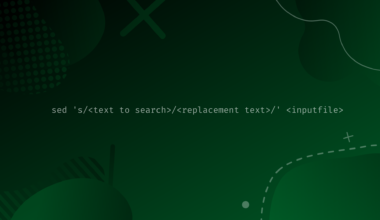CentOS is a community-driven Linux distribution, which is an official fork of RedHat Enterprise Linux (RHEL).
But after the announcement from RedHat about ending support from CentOS 8 and shifting focus to CentOS Stream, this whole scenario was in jeopardy and left the entire community in an uncomfortable situation.
In this article, we’ll try to explain what happened with CentOS 8 and CentOS Stream in a beginner-friendly way, and discuss what may happen in the future and what you can do next.
Table of Contents
Brief History of CentOS
CentOS, short for Community Enterprise Linux Operating System, was founded in 2004. It is a community-driven project that is mainly a rebuild of RedHat Enterprise Linux (RHEL).
It is open-source and uses Red Hat’s source code to create a final product very similar to RHEL. As CentOS doesn’t cost any money for support and subscription but provides almost the same features as RHEL, it is immensely popular among developers and companies.
Red Hat acquired CentOS in 2014 and let them work freely and release stable versions based on the release of RHEL. IBM bought Red Hat in 2019.
RedHat Announcement
In September 2019, RedHat announced CentOS Stream, an upstream development platform designed for CentOS. On December 8, 2020, CentOS and RedHat announced the end-of-life (EOL) for CentOS Linux, and they also told others to shift focus to the CentOS Stream project.
After the release of CentOS 8, CentOS and Red Hat said that CentOS 8 would be supported through 2029.
But from the recent announcement, we know that CentOS Linux 7, which is a downstream of RHEL 7, will continue support, and its lifecycle will end in June 2024, just like RHEL 7.
But CentOS Linux 8 updates and support have continued until December 31, 2021, and there will be no CentOS Linux 9.
CentOS Fedora RedHat
Red Hat has two main community projects on Linux distribution: Fedora and CentOS.
Now let’s understand what is an upstream and downstream.
Previously, CentOS was a rebuild of RHEL’s stable version.
And for Fedora Linux, Fedora is the upstream or development branch of RHEL. All the latest updates, patches, and other relevant things are first put into Fedora, then getting feedback from the community; it is merged into the stable RHEL release.
So, an upstream is basically the testing playground where the latest updates are continuously being pushed, and after proper fixation, all those fixes are put into a stable release.
So, the workflow is like this:
Fedora (upstream) → RHEL (stable) → CentOS Linux (downstream)
Current Scenario with CentOS Stream
After the announcement, we learned about the new distro release of CentOS, which is CentOS Stream, developed through collaboration between the CentOS community and RedHat. Red Hat sees CentOS Stream as a DevOps-friendly, continuous integration and continuous delivery (CI/CD) Linux, which will track just ahead of a current RHEL release.
But Red Hat CTO Chris Wright said, “CentOS Stream isn’t a replacement for CentOS Linux.”
So, by far, we can understand that CentOS Stream will not be a perfect rolling-release distro for RHEL. Instead, it will be a development version of RHEL and will be used as an upstream branch of RHEL. So, any significant change in Fedora should be reflected in CentOS Stream first; then, it would come to RHEL in parallel.
Now the release workflow will be like this:
Fedora → CentOS Stream → RHEL (stable)
And now we have two upstream branches of RHEL; I don’t know why. Wright said, “CentOS Stream now sits between the Fedora Project’s operating system innovation and RHEL’s production stability.” So, they meant even if CentOS stream is an upstream of RHEL, it still has the stability of being used in production.
But the scenario for CentOS stream users is, they will get all the latest flavors of the new RHEL but won’t get any stable release. All the stability, bug fixing and security updates will be resolved only in the latest RHEL release only. It probably sounds pretty confusing.
Community Response to CentOS Changes
The entire premise and the only reason anyone uses CentOS is that it’s rebuilt RHEL after releasing a stable RHEL with no cost.
For years, experienced Linux users have used CentOS for their Linux server, like Facebook has many servers running on CentOS. The vast majority of web and server-hosting companies offered CentOS as their default operating system mainly because of its stability and no cost.
But now, you can’t just switch to CentOS Stream as it is not as same as CentOS Linux was before. CentOS stream is an upstream “testing” branch for RHEL. By making CentOS a test upstream distribution, it completely destroys its usage of being the stable, free, enterprise-ready operating system.
The community is very negative about the announcement and has shared their thoughts on different platforms. People call it a profit motivated move, and money-grabbing tendency of RHEL. People are saying that RedHat bought CentOS just to kill it.
Mike McGrath, Red Hat’s VP of Linux Engineering, even said. “I would say the big one for us was that CentOS itself was not actually providing that much usefulness to Red Hat.”
No one has a problem with CentOS Stream existing. What people have a problem with is discontinuing CentOS 8 and 7 and breaching the commitments CentOS, RedHat and IBM made.
RedHat benefited a lot from the massive CentOS community, but now seeing their repayment hurts the community’s trust. There’s even a Change.org petition to revert the decision that has over 12,360 signatures to date, making it one of the top petitions there.
After the massive backlash Red Hat has tried to defend, they started saying that the “message could have been conveyed in a better way“.
Alternatives to CentOS
As you can now anticipate, the CentOS Project’s adjustments have pushed many people to explore CentOS alternatives.
One option is to forsake RHEL-like operating systems entirely and replace them with Ubuntu or Debian. This path, on the other hand, does not truly fill the same void that CentOS Linux did.
RedHat, to their credit, is working to provide customers with options, such as free developer subscriptions. If RedHat’s offerings aren’t perfect for you and you want a CentOS alternative that comes with no cost but production-ready, here are some options:
Rocky Linux

CentOS co-founder Greg Kurtzer is one of the many community members who aren’t happy about Red Hat’s decision to shutter CentOS Linux.
After RedHat’ announcement, he released a press statement and said, “In response to this unexpected shift, I am proud to announce the launch of a new project, Rocky Linux, in honor of my late CentOS co-founder Rocky McGough“.
Rocky Linux aims to be a “100% bug-for-bug compatible” version of RHEL. Rocky tracks and follows RHEL releases very closely. For example, RHEL 8.5, was released in November 2021, and Rocky Linux 8.5 followed right on its heels a few days later. Commercial support is also available through Kurtzer’s company, Ctrl IQ, which is also the primary sponsor of Rocky Linux along with AWS, Microsoft, VMware, Google Cloud etc.
As there is a tremendous demand for a replacement for CentOS, Rocky is buzzing on the top, being a clone of a stable RHEL release. People seem to have an emotional attachment with Rocky, as a board member of CentOS project is also with Rocky Linux. In the first 72 hours post-launch, there were 70,000 downloads from their tier 0 mirror alone.
Alma Linux

CloudLinux, which maintains its own commercial Linux distribution, called CloudLinux OS, created a free open-source Linux Operating system named AlmaLinux.
AlmaLinux OS is a 1:1 binary compatible fork of RHEL. Like Rocky Linux, they also follow the same release version after RHEL stable release. Even if CloundLinux is now sponsoring them, they now belong to a 501(c)(6) non-profit organization that will take responsibility for managing AlmaLinux.
So, they will always be a community-driven distro, forever free and open-source, with no licenses or usage restrictions.
CloudLinux is best known for its hardened security, with security patches often now will be available even to AlmaLinux before they even reach RHEL.
Being an enterprise-ready OS with the stability of RHEL, and also the backing of corporations, AlmaLinux has caused a stir in IT world.
Individuals and organizations that require an enterprise-grade, CentOS stable distribution but who do not want to or cannot pay for a RHEL license, AlmaLinux OS is also a perfect replacement for them.
Oracle Linux

Oracle Linux is a free Linux distribution that Oracle develops and publishes. This version is built from RedHat Enterprise Linux sources, with the RedHat branding replaced by Oracle’s.
Oracle Linux provides a 100% application binary-compatible alternative to Red Hat Enterprise Linux and CentOS Linux and is supported across both hybrid and multicloud environments.
If you have Oracle products in your production systems, using Oracle Linux will benefit you as it would be more efficient than other Linux versions.
Aside from that, Oracle Linux provides the stability that production systems require. This OS is backed by Oracle, so they have a large community.
You can also use the community to share your technical concerns and receive feedback. The only drawback is that they have paid support and might have compatibility issues integrating with other products that Oracle doesn’t support.
Others
There are also many other projects and distros made from RHEL to provide playgrounds like RHEL and become a true replacement of CentOS. Some notable ones are:
- CloudLinux OS (enterprise and fine-tuned OS by CloudLinux)
- Springdale Linux (maintained by members of Princeton University) ClearOS (from Hewlett Packard Enterprise, HPE and Clear Center)
- Amazon Linux (AWS’s own in-house Linux OS)
Conclusion
Different people may have different opinions about the announcement of CentOS stream and the future of CentOS Linux. There are several viable CentOS alternatives, paid or free, for those who want to migrate from CentOS.
What we have done here is essentially have a brief discussion on them, but it is really up to you to choose between what you want from your operating system and how you want them. Leave a comment to share your thoughts.
References
- https://blog.centos.org/2020/12/future-is-centos-stream/
- https://www.redhat.com/en/blog/transforming-development-experience-within-centos
- https://www.redhat.com/en/blog/centos-stream-building-innovative-future-enterprise-linux
- https://www.redhat.com/en/blog/faq-centos-stream-updates
- https://blog.centos.org/2020/12/centos-stream-is-continuous-delivery/
- https://blog.centos.org/2020/12/balancing-the-needs-around-the-centos-platform/






